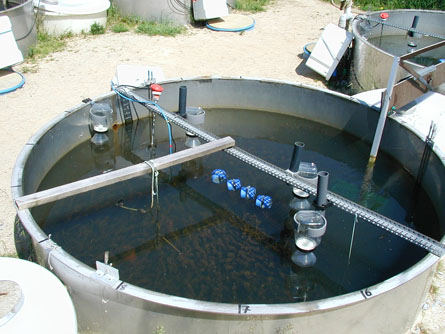
The artificial lakes (mesocosms) consist of 24 stainless steel tanks (2800 l), which simulate shallow lakes. The lakes were established in a standardised way in 2003, and there have been no changes in either set-up or biology since the establishment. At that time. 30 cm standard lake sediment was added to each tank as well as a 1 m water column, which was inoculated with a natural freshwater community of algae, small animals, zooplankton and sticklebacks from both nutrient-poor and nutrient-rich lakes. Submerged macrophytes were introduced together with the sediment. The mesocosms are treated with three temperatures and two nutrient levels yielding four tanks with the exact same treatment combination. Heating is done with electrical heating elements placed at the bottom and, depending on season and treatment, the heating follows the IPCC’s A2 scenario of 2.5 to 6.6 °C above the unheated temperature (control).
Since the establishment in 2003, the mesocosms have been used within the framework of a number of projects, including the Villum Kann Centre of Excellence CLEAR. The mesocosm facility is now part of the Danish AnaEE project, and it is also included in the European AnaEE list of experimental facilities for ESFRI. The facility was part of the FP7 projects REFRESH project and MARS (http://www.mars- project.eu), running from 2014-2018, to assess effects of a heat-wave on shallow lakes. Additional projects are the European JPI Water project PROGNOS (2016-2019), assessing in-lake responses to change using near real-time models, and a Danish lake restoration project (CLEAR from 2012-2017; a Villum Kann Rasmussen Centre of Excellence on lake restoration), involving a 15N spiking experiment. In recent years, the facility has been part of AQUACOSM and AQUACOSM plus, Horizon 2020 infrastructure projects, which facilitated over 1400 days of transnational access to the facility over 8 years.
The experimental site is unique and is the longest running climate experiment in the world. The set-up is today adapted to the future climate scenarios and uniquely allows for making realistic predictions about the impacts of the future climate change on our lakes. In recent years, a number of high frequency measurements have been added with chlorophyll and phycocyanin (blue-green algal pigment) sensors recording algal biomass at high temporal resolution.
In addition, a low cost, bespoke system developed together with engineers at AU measures carbon dioxide and methane fluxes six times daily.